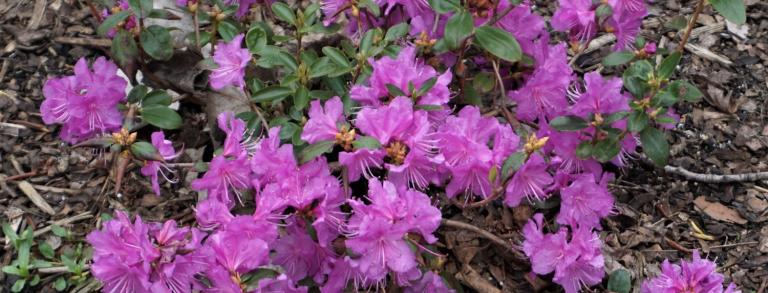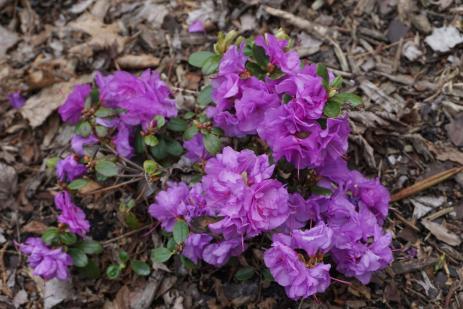WE ALL KNOW that the best rock gardens are not just tiny perennials and rocks. To be interesting year around, dwarf evergreens and miniature shrubs are needed to add structure to the garden. With their dense, compact growth, I like to think of them as living transitions between boulders and alpines. In the mountains, the landscape above the timberline is dotted with gnarly evergreens and crawling or mounded shrubs. Re-creating this scene takes some effort because commonly offered conifers and shrubs are grown for large landscapes, not for detail-oriented, small-scale rock gardens. Cute in a pot, they quickly outgrow their place and shade out or smother their diminutive neighbors. Dwarf conifers are a subject of their own and are often described while other dwarf shrubs tend to be overlooked. Not often are the delights of miniature rhododendrons revealed, though they bloom beautifully and are in scale with flowering alpines.
Mountaintops are cool, windy, and sunny with rocky, well-drained soil. The rhododendrons that naturally thrive there have small leaves on densely twiggy branches. They blossom early and hunker down in the shelter of rocks. North-facing slopes offer snow cover for evergreen rhododendrons but those that lose their leaves in winter or have small, thyme-like leaves can grow in full sun. That sun tolerance makes them suitable for rock gardens placed in sun. They are all scaly-leaved types, also called small leaved or lepidotes, and evolved growing in sun. Rhododendron ‘PJM’, though too large for most rock gardens, is a lepidote and blooms best in sun. Large-leaved types of rhododendrons grow at lower elevations or are woodlanders, needing partial shade, especially where summers are hot.
Rhododendron Species
Rhododendron dauricum has penny-size, oval leaves that stick around all year. It naturally occurs from Japan, northward to Manchuria and Siberia. As their range extends northward, plants become semi-evergreen and finally deciduous. This protects the plants from desiccating in winter when water in the soil is frozen and unavailable. Winter burn is a drought situation. The smallest form is called R. dauricum ‘Nanum’ and is usually a vivid reddish-purple.
The related plants that grow farther north regularly drop their leaves in the fall and are called Rhododendron mucronulatum, though the two interbreed very easily in culture. Perhaps you have heard of R. mucronulatum ‘Cornell Pink’, which makes a spectacular show of sugar-pink flowers on a large plant bare of leaves, though the usual color of the species is lavender to magenta.
Growing in my garden, Rice Creek, is a bright lavender five foot (1.5 m) shrub that regularly blooms in April and sets lots of seed. I have been growing seedlings and selecting the most dwarf, and many show a “pansy” pattern on the flower with the center petal quite light. Larger ones are invaluable for early color because planted here and there around the garden they create drifts of color in the mid-size range between spring ephemerals on the ground and magnolias in the sky. Thus, your garden becomes volumetric, not just horizontal.
R. mucronulatum ‘Crater’s Edge’ (See the photos on the front and back covers) is a tiny, deciduous shrub, covered in coral flowers in April. It gets its name because its origin is a volcanic crater in the mountains of Korea.
Dwarf forms of both R. dauricum and R. mucronulatum are extremely easy to grow from seed and will flower in approximately three years. They stay a foot or less in height and bloom very early when drabas and species bulbs are lighting up rock gardens. Shades of fuchsia, pink, lavender, and white are very welcome in early spring when you really need flowers.
In milder climates, a variety of other small species can be grown, but these two are the hardiest. Through further hybridization of these supremely hardy species and half-hardy lepidotes, different colors and habits can be passed on for northern gardeners to enjoy.
Miniature Rhododendron Hybrids
Plants with double quotes are our unregistered hybrids but I mention them because they show promise for the future. Those available commercially have single quotes, are recommended and have thrived through -35°F (-37°C) winters and 100°F (38°C) summers.
“Blue Roses” is our hybrid of ‘April Rose’, which is a large, very hardy, wine-colored flowered shrub, crossed with a half-hardy blue dwarf species.
We named our dwarf, double R. dauricum x R. dendrocharis “Chickadee” because what says “D-D-D” but that rascally little bird? The stamens (male, pollen-bearing parts) have turned into petals, leaving the pistil able to take pollen. We have seedlings made with ‘Crater’s Edge’ pollen coming along and hope to find a pink rose-form among them.
“Jack-in-the-Box” resembles a flowering boxwood, forming a slow-growing globe. Although its parents are unknown, it is extremely hardy.
‘Karen Seleger’ is available commercially and has reddish-violet flowers.
‘Karen’s’ is the one and only commercial evergreen azalea hardy here. It has been around a long time and is commercially available. This variety likes at least a half-day of sun for best flowering.
‘Purple Gem’, though eventually growing to three feet (0.9 m), has proven hardiness and is widely available.
‘Robert Seleger’ makes a cupcake of baby pink flowers.
‘Windbeam’ has thrived for over 40 years here. It is a charming addition to semi-shade gardens.
I hope that once these possibilities are known and plants become available, they will inspire more experimentation to make our gardens capture a wider variety of natural beauty.



